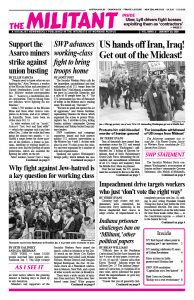Tens of thousands have joined demonstrations across the U.S. and around the world against Washington’s Jan. 2 killing of Qassem Soleimani, head of Iran’s Revolutionary Guard Quds Force, demanding the immediate and unconditional withdrawal of all U.S. troops and weaponry from the Middle East. More are planned.
Over the last week, the U.S. government has escalated its forces in the Mideast to over 80,000 Army, Marine and naval forces and sent additional B-52 bombers and other armaments.
Washington’s deadly drone strike near Baghdad airport also killed six others, including Abu Mahdi al-Muhandis, deputy commander of the Iraqi Popular Mobilization Forces, militias organized by the Iranian rulers in Iraq to advance their intervention there. Muhandis commanded the Kataeb Hezbollah militia that Washington held responsible for recent attacks on U.S. military bases in Iraq and the U.S. Embassy in Baghdad.
The Donald Trump administration said the killings, as well as airstrikes in Iraq Dec. 29 that killed and wounded dozens of militia members, were necessary to defend the lives of U.S. troops deployed across the region.
The reactionary clerical regime in Tehran responded with threats of retaliation worldwide. Tens of thousands of largely middle-class, conservative pro-regime forces carrying government-printed signs saying “Death to America” mobilized in religious centers and Tehran after the regime announced four days of mourning for Soleimani. Over 50 people were killed and hundreds injured in a stampede during the planned funeral service for the military figure Jan. 7, leading to its postponement.
Iran’s rulers also used the occasion to increase the state budget for Quds Force operations by over $220 million.
Trump threatened further strikes if there were any new attacks on U.S. forces, saying the administration had targeted “52 Iranian sites” that would be hit “very fast and very hard,” including Iranian cultural sites.
Decades of war, U.S. intervention
Both Washington and Tehran have been locked in a long-term conflict, as each ruling capitalist class pushes to further its own economic, political and military interests in Iraq, Syria and other countries in the Middle East. Their conflict is part of broader clashes between U.S. imperialism, Moscow, Ankara and other regional capitalist rivals.
Iran’s rulers aim to increase their regional sway by force of arms, extending beyond their border the nearly four-decade-long, cleric-dominated political counterrevolution that pushed back the workers, farmers, women and oppressed nationalities who carried out the mass popular Iranian Revolution of 1979. Soleimani was the central organizer of the Iranian rulers’ wars across the Middle East.
The U.S. rulers have been bogged down in decades of wars in the region, under both Democratic and Republican administrations.
Washington reimposed sanctions on Iran in 2018 and then cranked them up, with ruinous consequences for working people there, who’ve been hit with huge price rises and shortages of basic necessities. The Iranian rulers place the cost of their military adventures on the backs of workers and farmers.
Pro-Tehran politicians and organized militias, who dominate the government in Iraq, have stepped up their drive to push Washington back. Iraq’s parliament adopted a motion Jan. 5 demanding the expulsion of Washington’s 5,000 troops stationed in the country. But the resolution was “nonbinding.” Virtually all Sunni and Kurdish delegates boycotted the session, despite threats from the Kataeb Hezbollah militia, who “ordered” all delegates to attend.
The Pentagon told the press Jan. 6 that Washington has no intention of leaving Iraq. And Defense Secretary Mark Esper said that the U.S. military will “follow the rules of armed conflict” — which means no attack on cultural sites or institutions.
Iranian Foreign Minister Javad Zarif announced Tehran had now “concluded” its armed retaliation against Washington after the regime fired some two dozen missiles at bases in Iraq where U.S. and other U.S.-coalition troops — Iraqis and troops from Australia, Britain, Denmark, Poland and Sweden — are based. The missiles hit a base in Sunni-populated western Anbar province and another near Erbil in the northern Kurdish region. Zarif said Tehran did “not seek escalation or war.”
President Trump, surrounded by Pentagon brass Jan. 8, confirmed there were no casualties and that Tehran “appears to be standing down.” He celebrated the killing of Soleimani, stressed the U.S. rulers have the most powerful military in the world by far, and urged NATO to join Washington in its Middle East operations. He said Washington would levy yet another round of economic sanctions on Tehran, but did not announce any new military moves.
Trump demanded a new, more effective nuclear deal and offered to work with the Iranian rulers — if they back off all nuclear ambitions and their expansionary posture in the region — to “build a great future.”
Iraq protests: ‘No to Iran, no to U.S.’
Democratic Party politicians and the liberal press that backs them insist that the Trump administration is out to start a war. They claim U.S. actions have caused the Iranian people to line up behind the clerical regime and Iraqis to turn their backs on months of protests against the regime there.
But this isn’t true. Working-class protests against Tehran’s adventures abroad and crisis conditions at home rocked the country last fall. They were ended by brutal repression — the murder of over 300 people, arrests of thousands, shutting down the internet and social media.
“How do they expect people to rally behind them and support their cause for vengeance when they beat the same people on the streets and cut their internet just a few weeks ago?” 30-year-old Atena, who feared to use her last name, told Bloomberg News Jan. 4.
At protests in over 100 Iranian cities in November, Soleimani was often called out by name during chants in opposition to Tehran’s interventions in Syria, Gaza, Lebanon and Yemen. Pointing to the Iranian rulers, Atena said, “This is their loss, not mine.”
In Iraq, protests continue throughout majority Shiite areas in the country’s south. From the beginning working people have spoken out against interference in Iraq by both Tehran and Washington.
Hundreds of demonstrators chanted “No to Iran, no to America” at a protest in the southern Iraqi city of Diwaniyah Jan. 5. Participants in similar protests clashed with pro-Tehran militia forces mourning Soleimani and Muhandis in Nasiriyah and Basra the same day, reported Middle Eastern Eye News.
Soleimani’s recent visits to Iraq included helping direct Tehran-backed militia forces in carrying out deadly assaults on those protesting the government and Tehran’s interference there.


